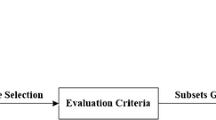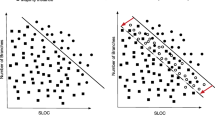Abstract
Defect prediction in software projects plays a crucial role to reduce quality-based risk and increase the capability of detecting faulty program modules. Hence, classification approaches to anticipate software defect proneness based on static code characteristics have become a hot topic with a great deal of attention in recent years. While several novel studies show that the use of a single classifier causes the performance bottleneck, ensembles of classifiers might effectively enhance classification performance compared to a single classifier. However, the class imbalance property of software defect data severely hinders the classification efficiency of ensemble learning. To cope with this problem, resampling methods are usually combined into ensemble models. This paper empirically assesses the importance of sampling with regard to ensembles of various classifiers on imbalanced data in software defect prediction problems. Extensive experiments with the combination of seven different kinds of classification algorithms, three sampling methods, and two balanced data learning schemata were conducted over ten datasets. Empirical results indicated the positive effects of combining sampling techniques and the ensemble learning model on the performance of defect prediction regarding datasets with imbalanced class distributions.


Similar content being viewed by others
References
Khuat TT, Le MH. A novel hybrid ABC-PSO algorithm for effort estimation of software projects using agile methodologies. J Intell Syst. 2018;27:489–506.
Khuat TT, Le MH. An effort estimation approach for agile software development using fireworks algorithm optimized neural network. Int J Comput Sci Inf Secur. 2016;14:122–30.
Khuat TT, Le MH. Optimizing parameters of software effort estimation models using directed artificial bee colony algorithm. Informatica. 2017;40:427–36.
Laradji IH, Alshayeb M, Ghouti L. Software defect prediction using ensemble learning on selected features. Inf Softw Technol. 2015;58:388–402.
Yuan X, Khoshgoftaar TM, Allen EB, Ganesan K. An application of fuzzy clustering to software quality prediction. In: Proceedings of 3rd IEEE symposium on application-specific systems and software engineering technology; 2000; p. 85–90.
D’Ambros M, Lanza M, Robbes R. Evaluating defect prediction approaches: a benchmark and an extensive comparison. Empir Softw Eng. 2012;17:531–77.
Sun Z, Song Q, Zhu X. Using coding-based ensemble learning to improve software defect prediction. IEEE Trans Syst Man Cybern Part C (Appl Rev). 2012;42:1806–17.
He H, Garcia EA. Learning from Imbalanced data. IEEE Trans Knowl Data Eng. 2009;21:1263–84.
Akbani R, Kwek S, Japkowicz N. Applying support vector machines to imbalanced datasets. In: Proceedings of 15th European conference on machine learning; 2004; p. 39–50.
Japkowicz N, Stephen S. The class imbalance problem: a systematic study. J Intell Data Anal. 2002;6:429–49.
Bouguila N, Han WJ, Hamza AB. A Bayesian approach for software quality prediction. In: Proceedings of 4th international IEEE conference on intelligent systems; 2008; p. 49–54.
Batista GE, Prati RC, Monard MC. A study of the behavior of several methods for balancing machine learning training data. ACM SIGKDD Explor Newsl. 2004;6:20–9.
Sun Y, Kamel MS, Wong AKC, Wang Y. Cost-sensitive boosting for classification of imbalanced data. Pattern Recogn. 2007;40:3358–78.
Rokach L. Taxonomy for characterizing ensemble methods in classification tasks: a review and annotated bibliography. Comput Stat Data Anal. 2009;53:4046–72.
Wang T, Li W, Shi H, Liu Z. Software defect prediction based on classifiers ensemble. J Inf Comput Sci. 2012;8:4241–54.
Menzies T, Krishna R, Pryor D. The promise repository of empirical software engineering data. 2019. http://promise.site.uottawa.ca/SERepository/. Accessed 30 Sep 2019.
Menzies T, Greenwald J, Frank A. Data mining static code attributes to learn defect predictors. IEEE Trans Softw Eng. 2007;33:2–13.
Ostrand TJ, Weyuker EJ, Bell RM. Predicting the location and number of faults in large software systems. IEEE Trans Softw Eng. 2005;31:340–55.
Fenton NE, Neil M. Software metrics: successes, failures and new directions. J Syst Softw. 1999;47:149–57.
McCabe TJ. A complexity measure. IEEE Trans Softw Eng. 1976;2:308–20.
Card DN, Agresti WW. Measuring software design complexity. J Syst Softw. 1988;8:185–97.
Chidamber SR, Kemerer CF. A metrics suite for object oriented design. IEEE Trans Softw Eng. 1994;20:476–93.
Marcus A, Poshyvanyk D, Ferenc R. Using the conceptual cohesion of classes for fault prediction in object-oriented systems. IEEE Trans Softw Eng. 2008;34:287–300.
Turhan B, Menzies T, Bener AB, Stefano JD. On the relative value of cross-company and within-company data for defect prediction. Empir Softw Eng. 2009;14:540–78.
Dejaeger K, Verbraken T, Baesens B. Toward comprehensible software fault prediction models using Bayesian network classifiers. IEEE Trans Softw Eng. 2013;39:237–57.
Thwin MMT, Quah TS. Application of neural networks for software quality prediction using object-oriented metrics. J Syst Softw. 2005;76:147–56.
Rong X, Li F, Cui Z. A model for software defect prediction using vector machine based on CBA. Int J Intell Syst Technol Appl. 2016;15:19–34.
Huang J, Sun H, Li YF, Xie M. An empirical study of dynamic incomplete-case nearest neighbor imputation in software quality data. In: Proceedings of IEEE international conference on software quality, reliability and security; 2015; p. 37–42.
Lessmann S, Baesens B, Mues C, Pietsch S. Benchmarking classification models for software defect prediction: a proposed framework and novel findings. IEEE Trans Softw Eng. 2008;34:485–96.
Menzies T, Dekhtyar A, Distefano J, Greenwald J. Problems with precision: a response to comments on ’data mining static code attributes to learn defect predictors’. IEEE Trans Softw Eng. 2007;33:637–40.
Shanab AA, Khoshgoftaar TM, Wald R, Hulse JV. Evaluation of the importance of data pre-processing order when combining feature selection and data sampling. Int J Bus Intell Data Min. 2012;7:116–34.
Bowes D, Hall T, Gray D. DConfusion: a technique to allow cross study performance evaluation of fault prediction studies. Autom Softw Eng. 2014;21:287–313.
Weiss GM. Mining with rarity: a unifying framework. ACM SIGKDD Explor Newsl. 2004;6:7–19.
Gonzalez-Abril L, Nunez H, Angulo C, Velasco F. GSVM: an SVM for handling imbalanced accuracy between classes inbi-classification problems. Appl Soft Comput. 2014;17:23–31.
Tahir MA, Kittler J, Yan F. Inverse random under sampling for class imbalance problem and its application to multi-label classification. Pattern Recogn. 2012;45:3738–50.
Seiffert C, Khoshgoftaar TM, Hulse JV. Improving software-quality predictions with data sampling and boosting. IEEE Trans Syst Man Cybern. 2009;39:1283–94.
Zheng J. Cost-sensitive boosting neural networks for software defect prediction. Expert Syst Appl. 2010;37:4537–43.
Japkowicz N. The class imbalance problem: significance and strategies. In: Proceedings of the 2000 international conference on artificial intelligence; 2000; p. 111–7.
Mani I, Zhang J. KNN approach to unbalanced data distributions: a case study involving information extraction. In: Proceedings of international conference on machine learning; 2003.
Chawla NV, Bowyer KW, Hall LO, Kegelmeyer WP. SMOTE: synthetic minority over-sampling technique. J Artif Intell Res. 2002;16:321–57.
Han H, Wang WY, Mao BH. Borderline-SMOTE: a new over-sampling method in imbalanced data sets learning. In: Proceedings of international conference on intelligent computing; 2005; p. 878–87.
Xie J, Qiu Z. The effect of imbalanced data sets on LDA: a theoretical and empirical analysis. Pattern Recogn. 2007;40:557–62.
Tang EK, Suganthan PN, Yao X. An analysis of diversity measures. Mach Learn. 2006;65:247–71.
Aggarwal CC. Data mining. Berlin: Springer; 2015.
Diez-Pastor JF, Rodriguez JJ, Garcia-Osorio CI, Kuncheva LI. Diversity techniques improve the performance of the best imbalance learning ensembles. Inf Sci. 2015;325:98–117.
Blaszczynski J, Stefanowski J. Neighbourhood sampling in bagging for imbalanced data. Neurocomputing. 2015;150:529–42.
Kittler J, Hatef M, Duin RPW, Matas J. On combining classifiers. IEEE Trans Pattern Anal Mach Intell. 1998;20:226–39.
Kuncheva LI, Rodriguez JJ. A weighted voting framework for classifiers ensembles. Knowl Inf Syst. 2014;38(2):259–75.
Onan A, Korukoglu S, Bulut H. A multiobjective weighted voting ensemble classifier based on differential evolution algorithm for text sentiment classification. Expert Syst Appl. 2016;62:1–16.
Barandela R, Valdovinos RM, Sanchez JS. New applications of ensembles of classifiers. Pattern Anal Appl. 2003;6:245–56.
Wang S, Yao X. Diversity analysis on imbalanced data sets by using ensemble models. In: IEEE symposium on computational intelligence and data mining; 2009; p. 324–31.
Roy A, Cruz R, Sabourin R, Cavalcanti G. A study on combining dynamic selection and data preprocessing for imbalance learning. Neurocomputing. 2018;286:179–92.
Branco P, Torgo L, Ribeiro RP. A survey of predictive modeling on imbalanced domains. ACM Comput Surv. 2016;49(2):31:1–50.
Ruta D, Gabrys B. Classifier selection for majority voting. Inf Fusion. 2005;6(1):63–81.
Khoshgoftaar TM, Allen EB. Logistic regression modeling of software quality. Int J Reliab Qual Saf Eng. 1999;6:303–17.
Han J, Kamber M, Pei J. Data mining: concepts and techniques. Los Altos: Morgan Kaufmann; 2012.
Quinlan JR. C4.5: programs for machine learning. Los Altos: Morgan Kaufmann Publishers Inc.; 1993.
Frank E, Hall MA, Witten IH. The WEKA workbench. Online appendix for data mining: practical machine learning tools and techniques. Los Altos: Morgan Kaufmann; 2016.
Fisher DH, Xu L, Zard N. Ordering effects in clustering. In: Proceedings of the 9th international workshop of machine learning; 1992; p. 162–8.
Platt JC. Fast training of support vector machines using sequential minimal optimization. In: Advances in kernel methods 1999; p. 185–208
Aha DW, Kibler D, Albert MK. Instance-based learning algorithms. Mach Learn. 1991;6:37–66.
Demsar J. Statistical comparisons of classifiers over multiple data sets. J Mach Learn Res. 2006;7:1–30.
Iman RL, Davenport JM. Approximations of the critical region of the Friedman statistic. Commun Stat Theory Methods. 1980;9(6):571–95.
Holm S. A simple sequentially rejective multiple test procedure. Scand J Stat. 1979;6:65–70.
Acknowledgements
This research was supported by the Ministry of Education and Training of Vietnam under Grant Number B2019-DNA-03.
Author information
Authors and Affiliations
Corresponding author
Ethics declarations
Conflict of interest
The authors declare that they have no conflict of interest.
Additional information
Publisher's Note
Springer Nature remains neutral with regard to jurisdictional claims in published maps and institutional affiliations.
Rights and permissions
About this article
Cite this article
Khuat, T.T., Le, M.H. Evaluation of Sampling-Based Ensembles of Classifiers on Imbalanced Data for Software Defect Prediction Problems. SN COMPUT. SCI. 1, 108 (2020). https://doi.org/10.1007/s42979-020-0119-4
Received:
Accepted:
Published:
DOI: https://doi.org/10.1007/s42979-020-0119-4




